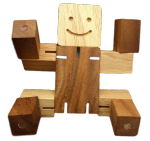Teaching Child Manners
Teaching child manners is a gradual process. It can take many reminders before your child learns to say "Would you please pass the butter?" But if you set a good example, and are patient and try not to get frustrated with your kids, they will eventually learn.
Teaching child manners is also an ongoing process. You may feel you've succeeded in teaching your 5-year-old certain important manners. But when she's 8, she suddenly becomes more surly and rude. You have to continue to emphasize the same messages. Compliment your child when he is polite.
The different stages in teaching child manners :
Toddlers
- Set the stage for learning polite behavior by being polite yourself. Always say "please" and "thank you."
- Promote empathy by talking about how other people feel when they're hurt. For instance, if you're reading a story like "Cinderella," you could talk about how hurt Cinderella was because her stepsisters were mean to her.
- Introduce sharing and turn-taking, although it's still tough at this age.
- Wash hands and face before meals.
- Use a bib (precursor to napkin).
- Promote use of spoon, and then a fork, and cup.
- Have the child sit at table in a high chair, but only use the high chair for eating and have the child leave the table when fussy.
- If you're going to a restaurant, bring small toys or crayons so the child can be occupied.
- Respond calmly to tantrums.
Ages 3 to 5
This is the prime time for teaching child manners. Child at this age like rules in general, and they also love to master new skills and to please you.
- Emphasize "magic words." As the child gets older, introduce phrases like "Excuse me" and "You're welcome."
- Rephrase things the right way. For instance, if your child says "Get me a glass of water," you can say, "May I have a glass of water, please?" and ask your child to repeat. You'll have to do this many times in many situations. Say "What do you say?" or "What's the magic word?"
- Set the stage for sharing. It's still hard at this age. If your child grabs someone else's toy, say, "It's not OK to take a friend's toy without asking. How do you think that makes Tommy feel?"
- Let the child help with simple chores around the house (emptying wastebasket or bringing silverware to the table) to introduce the notion of helpfulness in the family, and teach basic telephone manners.
- Should be able to stay seated at table for 15 to 20 minutes.
- Say please when asking for items
- Eat with utensils, not fingers - unless eating obvious finger food.
- Don't make bad comments about the food. If you don't want something just say "No, thank you."
- Chew with mouth closed.
- Sit with good posture without elbows on table.
- Ask to be excused from table.
- Indoor voice and outdoor voice - teach that there are places where its OK for him to be loud and places where he must be quiet.
- Can say more than hi and bye. Look someone in the eyes when saying hello.
- Can practice shaking hands at home.
Parent's role in teaching child manners
Children learn from manners their parents display. As such, the role a parent play in teaching child manners is of utmost importance.
Treat children with respect and they will learn to respect others. Talk kindly to your children and they learn how to talk kindly to others. It is also helpful to talk to children regarding how to respond in specific situations to better prepare them for when these situations arise.
Share with your children so they understand the importance of sharing with others. Compliment them when you see them sharing with others.
Practice family politeness. Everyone in the family must practice "please" and "thank-you" policy in which, for example, no request is considered unless the person asking says "please." When one of your children forgets, just give him or her a look that says, "I'm waiting." They soon catch on. Use the same approach for saying "thank you."
Children should be encouraged to apologize when they are sorry for something they did. Apologies should be sincere. If they are not comfortable apologizing face to face, they should write an apology note. Good judgment should be used by the parent as to when an apology is appropriate.
Emphasize the right thing to do and compliment your children when they exhibit good manners, rather than criticizing them for using poor manners. Praise is a wonderful teacher. Tell your children how proud you are when you notice them being polite.
Model the manners you want your child to learn. If you talk when your mouth is full of food, the likelihood is your kids will do the same.
Instruct in small doses . Use a step-by-step fashion. For telephone etiquette, for instance, begin instruction with "hellos" and "good-byes," then teach asking the caller to "please wait a minute while I get my dad." Lastly, guide children to take messages. For table manners, work on one or two at a time.
Keep kids healthy. Children tend to behave badly when they're tired or hungry. Kids need sleep and nutritious foods to survive.
Be patient! Don't expect perfection when teaching child manners. As with any skill being taught, there will be mistakes along the way. Learning is a trial and error process. We all learn from our mistakes.
Other related articles on teaching child manners:
The Greatest Parenting Secret in history for the Best Behaved kids in town
Dealing with the Terrible Twos and beyond








New! Comments
Have your say about what you just read! Leave us a comment in the box below.